warning PONTIAC FIREBIRD 1995 Owners Manual
[x] Cancel search | Manufacturer: PONTIAC, Model Year: 1995, Model line: FIREBIRD, Model: PONTIAC FIREBIRD 1995Pages: 386, PDF Size: 19.66 MB
Page 2 of 386
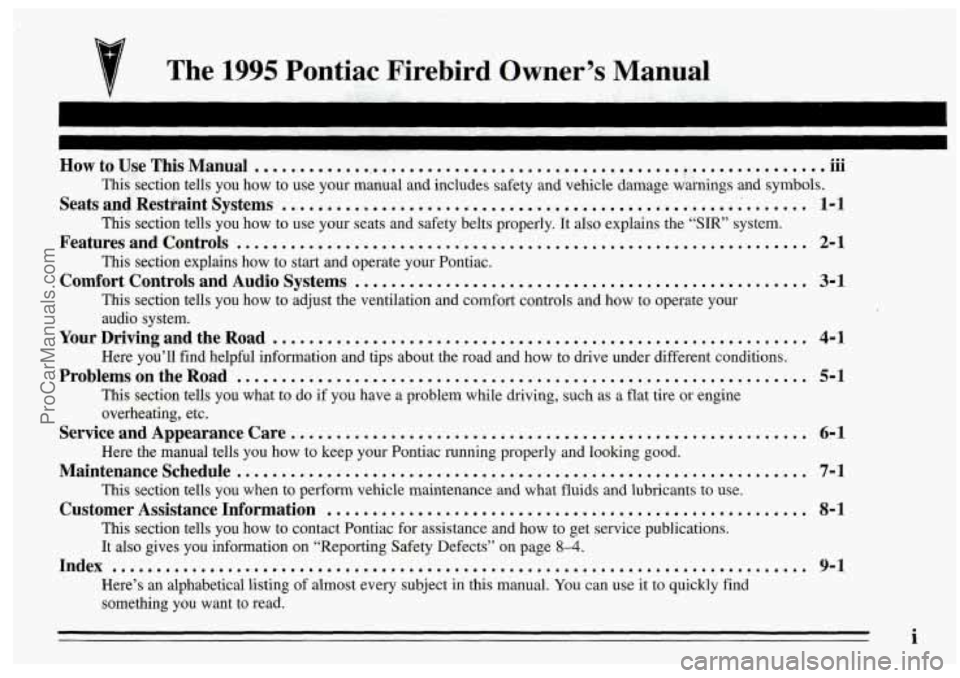
The 1995 Pontiac Firebird Owner’s Manual
... How to Use This Manual .............................................................. .m
Seats and Restraint Systems .................................................. .’ ....... 1-1
Features and Controls ............................................................... 2-1
Comfort Controls and Audio Systems .................................................. 3-1
This section tells you how to use your manual and includes safety and vehicle damage warnings\
and symbols.
This section tells
you how to use your seats and safety belts properly. It also explains the “SIR’ system.
This section explains how to start and operate your Pontiac.
This section tells you how to adjust the ventilation and comfo\
rt controls and how to operate your
audio system.
Here you’ll find helpful information and tips about the road\
and how to drive under different conditions.
This section tells you what to do if you have a problem whil\
e driving, such as a flat tire or engine
overheating, etc.
Here the manual tells you how to keep your Pontiac running properly and looking good.
This section tells you when to perform vehicle maintenance and what \
fluids and lubricants to use.
This section tells
you how to contact Pontiac for assistance and how to get service publications.
It also gives you information on “Reporting Safety Defects”\
on page 8-4.
Here’s an alphabetical listing of almost every subject in this manual. You can use it to quickly find
something you want to read.
Your Driving and the Road ........................................................... 4-1
ProblemsontheRoad ............................................................... 5-1
Service and Appearance Care ......................................................... 6-1
Maintenanceschedule ............................................................... 7-1
Customer Assistance Information
..................................................... 8-1
Index ........................................................................\
..... 9-1
i
ProCarManuals.com
Page 4 of 386
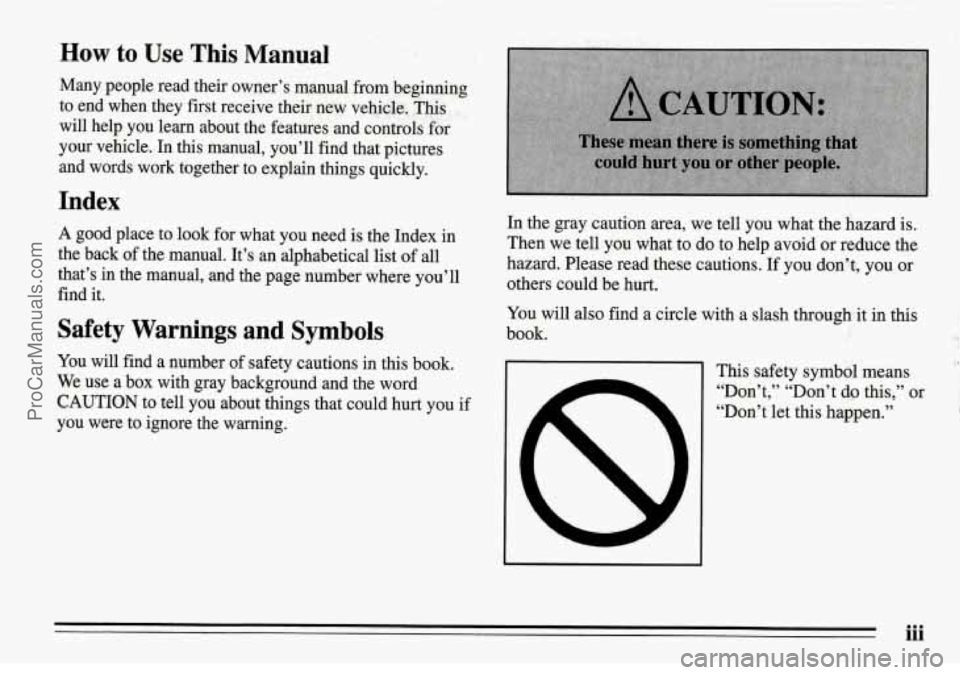
-*
:*: $1
How to Use This Manual
Many people read their owner’s manual fitom beginning
to end when they first receive their
riew vehiql?~.~ ,ms
will help you learn about the features and controis for
your vehicle. In this manual, you’ll find that pictures and words work together
to explain things quickly.
I .: ; ’
Index
A goad place to look for what you need is the Index in
the back of the manual. It’s
an alphabetical list of all
that’s
in the manual, and the page number where you’ll
find it.
Safety Warnings and Symbols
You will find a number of safety cautions in this book.
We
use a box with gray background and the word
CAUTION to, tell you about things that could hurt you if
you were to ignore the warning.
In the gray caution area, we tell you what the hazard is.
Then we tell you what to do to help avoid or reduce the
hazard. Please read these cautions.
If you don?, you or
others could be hurt.
You will also find a circle with a slash through it in this
book. -’.?
This safety symbol me’ans
“Don’t,’’ “Don’t
do this,’’ m. ~
“Don’t let this happen.” I
I
2 -.
iii
ProCarManuals.com
Page 5 of 386
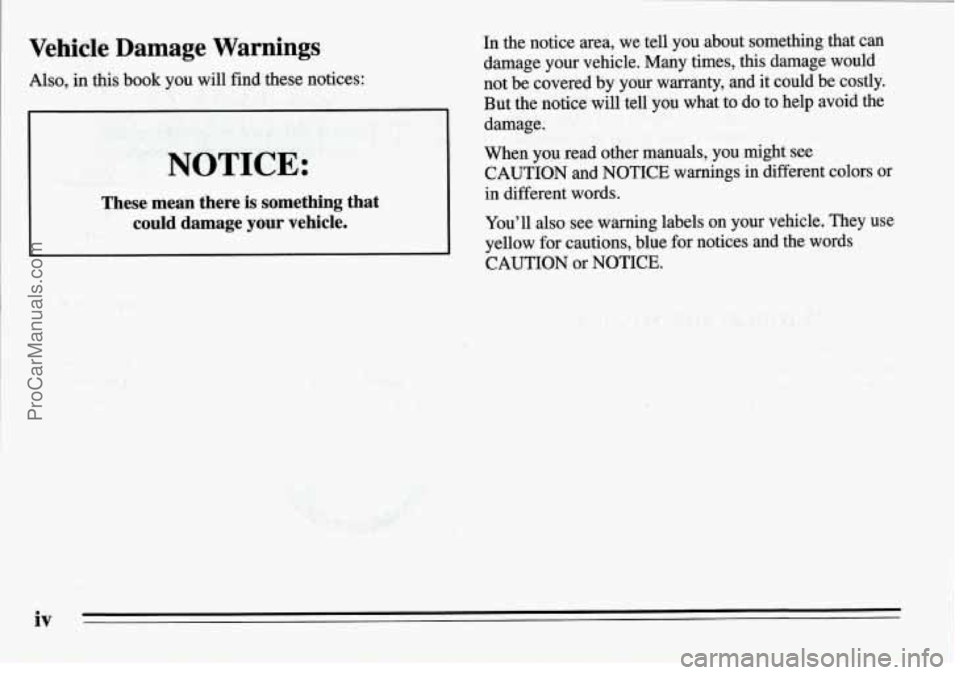
Vehicle Damage Warnings
Also, in this book you will fiid these notices:
NOTICE:
These mean there is something that
could damage your vehicle.
L
iv
1
In the notice area, we tell you about something that can
damage your vehicle.
Many times, this damage would
not be covered by your warranty, and it could be costly.
But the notice
will tell you what to do to help avoid the
damage.
When you read other manuals, you might. see
CAUTION and NOTICE warnings in different colors or
in different words.
You’ll also see warning labels on your vehicle. They use
yellow for cautions, blue
for notices and the words
CAUTION or NOTICE.
ProCarManuals.com
Page 6 of 386
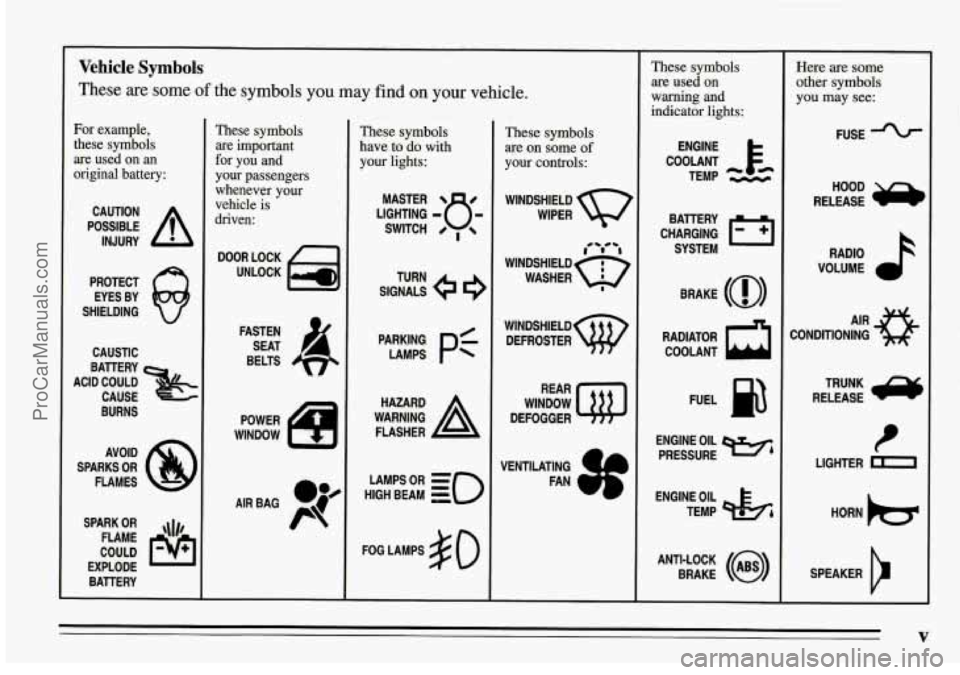
Vehicle Symbols
These are some of the symbols you may find on your vehicle.
For example, these symbols
are used on an
original battery:
POSSIBLE A
CAUTION
INJURY
PROTECT EYES BY
SHIELDING
CAUSTIC
BURNS
AVOID
SPARKS
OR
FLAMES
SPARK OR ,\I/,
COULD FLAME
EXPLODE BAllERY
These symbols
are important
for you and
your passengers
whenever your
vehicle is
driven:
FASTEN SEAT 4
BELTS
POWER
WINDOW
These symbols
have to
do with
your lights:
SIGNALS e
TURN
pAE: pf
HIGH LAMPSoR BEAM = =o
FOG LAMPS $0
These symbols are on some
of
your controls:
WINDSHIELD
WIPER
i ‘t’ i
WINDSHIELD Q
WASHER I
WINDSHIELD
DEFROSTER
WINDOW
DEFOGGER
VENTILATING FAN
These symbols
are used on
warning and
indicator lights:
COOLANT F*
TEMP --
ENGINE
CHARGING 1-1
BATTERY
SYSTEM
BRAKE (0)
RADIATOR COOLANT
a
FUEL
ENGINE OIL
PRESSURE
9%
TEMP OIL &
ANTI-LOCK (a)
BRAKE
-
Here are some
other symbols
you may see:
FUSE
RAM0 h
VOLUME
CONDITIONING AIR 43
RELEASE a
LIGHTER m
SPEAKER
b
V
ProCarManuals.com
Page 62 of 386

If you have an automatic transmission, the ignition
switch can’t be turned to
LOCK unless the shift lever is
in the PARK (P) position.
OFF (C): Unlocks the steering wheel, ignition and
automatic transmission, but does not send electrical
power to
any accessories. Use this position if your
vehicle must be pushed or towed.
A warning tone will
sound if you open the driver’s door when the ignition is
OFF and the key is in the ignition.
RUN (D): Position to which the switch returns after you
start your engine and release the switch. The switch
stays in the
RUN position when the engine is running.
But even when the engine is not running, you can use
RUN to operate your electrical power accessories and to
display some instrument panel warning and indicator
lights.
START (E): Starts the engine. When the engine starts,
release the key. The ignition switch will return to
RUN
for normal driving.
Note that even if the engine is not running, ACC and
RUN allow you to operate your electrical accessories,
such as the radio and ventilation fan.
Key Release Button: If you have a manual
transmission, your ignition lock has
a key release button.
You must press the button before you can take: your key
out
of the ignition lock.
2-15
ProCarManuals.com
Page 79 of 386
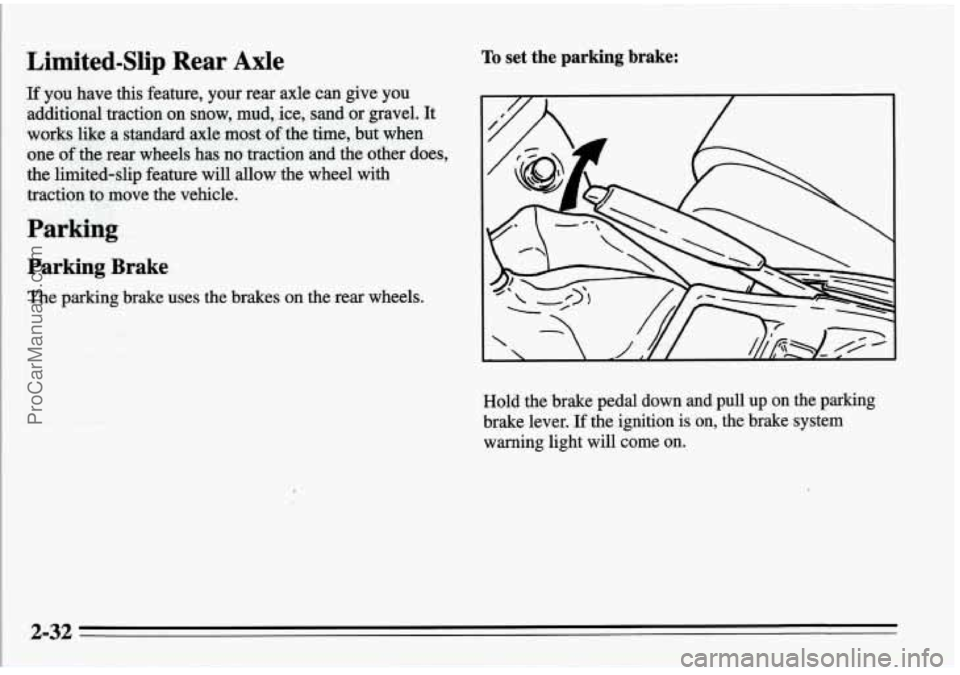
Limited-Slip Rear Axle
If you have this feature, your rear axle can give you
additional traction on snow, mud, ice, sand or gravel. It
works like a standard axle most
of the time, but when
one of the rear wheels has no traction and the other does,
the limited-slip feature
will allow the wheel with
traction to move the vehicle.
Parking Brake
The parking brake uses the brakes on the rear wheels.
To set the parking brake:
Hold the brake pedal down and pull up on the parking
brake lever.
If the ignition is on, the brake system
warning light
will come on.
ProCarManuals.com
Page 114 of 386

in either miles (used in the U.S.) or kilometers (used in
Canada).
Your Pontiac’s odometer is tamper-resistant. If you can
see silver lines between the numbers, probably someone
has tried to
turn it back. The numbers may not be true.
You may wonder what happens if your Pontiac needs a
new odometer installed.
If possible, the new one has to be
set to the same reading the old one had.
If it can’t be, then
it’s set at zero, but a label on the driver’s door must show
the old reading and when the new one was installed.
Trip Odometer
The trip odometer can tell you how far your car has been
driven since you last set the trip odometer to zero.
To set the trip odometer to zero, press the knob.
Tachometer
The tachometer displays the engine speed in thousands
of revolutions per minute (rpm).
I NOTICE:
I
Do not operate the engine with the tachometer in
the red area, or engine damage may occur.
Warning Lights, Gauges and Indicators
This part describes the warning lights and gauges that
may be on your vehicle. The pictures will help you
locate them.
Warning lights and gauges can signal that something is
wrong before it becomes serious enough to cause an
expensive repair or replacement. Paying attention to
your warning lights and gauges could also save you or
others from injury.
Warning lights go on when there may be or is, a problem
with one of your car’s functions.
As you will see in the
details on the next few pages, some warning lights come
on briefly when you turn the ignition key just to let you
know they’re working. If you are familiar with this
section, you should not be alarmed when this happens.
Gauges can indicate when there may be or is a problem
with one of your car’s functions. Often gauges and
warning lights work together to let you know ,when
there’s a problem with your car.
When one of the warning lights comes on and stays on
when you are driving, or when one of the gauges shows
there may be a problem, check the section that tells you
what to do about it. Please follow the manual’s advice.
Waiting to do repairs can be costly- and even
dangerous.
So please get to know your warning lights
and gauges. They’re a big help.
2-67
ProCarManuals.com
Page 116 of 386

Brake System Warning Light
Your Pontiac’s hydraulic
B RAKE two parts. If one part isn’t
brake system is divided into
working, the other part can
still work and stop you. For
good braking, though, you
need both parts working
If the warning light comes on, there could be a brake
problem. Have your brake system inspected right away.
This light should come on briefly as you start the
vehicle. If it doesn’t come
on then, have it fixed so it
will be ready to warn you if there’s a problem.
If the light comes on while you are driving, pull off the
road and stop carefully. You may notice that the pedal is
harder to push. Or, the pedal may
go closer to the floor.
It may take longer to stop. If the light is still on, or if the
anti-lock brake system warning light is flashing, have
the vehicle towed for service. (See “Anti-Lock Brake
System Warning Light” and “Towing Your Car” in the
Index.)
The brake system warning light will also come on when
you set your parking brake, and it will stay on if your
parking brake doesn’t release fully. If it stays on after
your parking brake is fully released, it means you have a
brake problem.
2-69
ProCarManuals.com
Page 117 of 386

Anti-Lock Brake System Warning Light
ABS
INOP
With the anti-lock brake system, this light will come on when
you
start your engine and it will stay on for three seconds.
That’s normal.
If the light doesn’t come on, have it fixed so it
will be ready
to warn you if there is a problem.
If the light flashes when you’re driving, you don’t have
anti-lock brakes and there could be a problem with your
regular brakes. Pull
off the road and stop carefully. You
may notice that the pedal is harder to push. Or, the pedal
may go closer to the floor. It may take longer to stop.
Have the vehicle towed for service. (See “Towing Your
Car” in the Index.)
If the anti-lock brake system warning light stays on
longer than normal after you’ve started your engine, turn
the ignition off. Or, if the light comes on and stays on
when you’re driving, stop as soon as possible and
tum
the ignition off. Then start the engine again to reset the
system.
If the light still stays on, or comes on again
while you’re driving, your Pontiac needs service.
If the
light
is on but not flashing and the regular brake system
warning light isn’t
on, you still have brakes, but you
don’t have anti-lock brakes.
2-70
ProCarManuals.com
Page 118 of 386

Traction Control System Warning Light
(Option)
i TCS
OFF
The traction control system will shut down partially due
to brake overheating but the TCS
OW light will not
come on.
If there is throttle overheating, the TCS OFF
light will illuminate and the system will shut down.
Once everything cools
off, the system will operate
normally again.
This light will also come on for three seconds each time
you start your vehicle as a bulb check and if there’s a
system failure. See “Traction Control System” in the
Index.
When the traction control system is off, the TCS OFF
light will stay on.
2-71
ProCarManuals.com